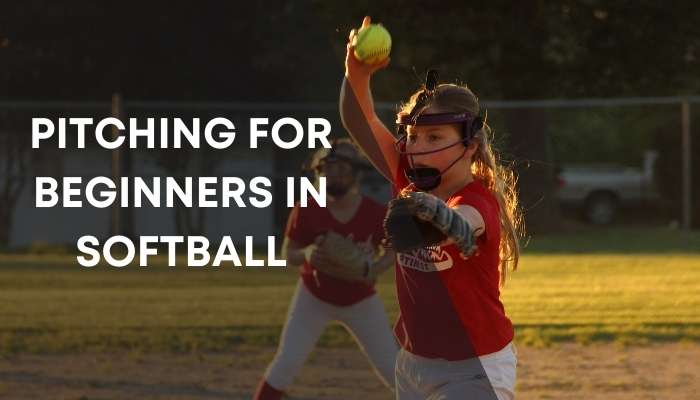Throwing caution to the wind is never a good idea, particularly when Pitching for Beginners in Softball. You can’t hurry softball pitching fundamentals. Most young softball pitchers don’t understand how difficult the position is, and the only way to become better is to accept that you may not be regarded as great right away.
Even a little change in style can impact the pitch’s accuracy, so pitchers and coaches should check for fatigue, injury, compensation, or desire for better outcomes.
Let your youngsters try different pitching styles to see what works best for them, but make sure they’re always under parental guidance.
In the following, I’ll outline the nine fundamental actions of the softball pitcher’s motion. Pitching advice for beginners might be challenging to understand, especially if you’re a parent or coach of a young fastpitch softball pitcher.
I’ll keep this short and sweet by outlining the fundamentals of teaching Pitching your kids in Softball.
Pitching for Beginners in Softball
The following tips for beginner pitchers in softball help them gain a feel for each part of the pitch before putting it all together. Pitchers must master the intricacies and actions of the full pitch before studying a drop or curve ball.
Taking things one step at a time lets you direct your team’s attention to whatever you think is most important. This lets you identify your players’ weakest skills and help them improve them.
Grip
The fastball should be your first pitch to learn. Based on how many seams are visible while the ball is spinning toward you, fastballs may be divided into two categories: four-seam and two-seam.
The four-seam will be your fastest and most reliable pitch. It should be the only fastball you worry about as a newbie until you throw 60% of the strikes.
The two-seam will move a little, but not as much or as fast as the four-seam. Punch grips and movements differ based on speed, hand size, and spin speed.
The two-seam fastball is often not a “go-to” pitch like the four-seam fastball, but it is an effective second strike. When you need a strike, use the four-seam.
The image below is a demonstration of a four-seam fastball grip. The ball has two forward and two backward “C’s”.
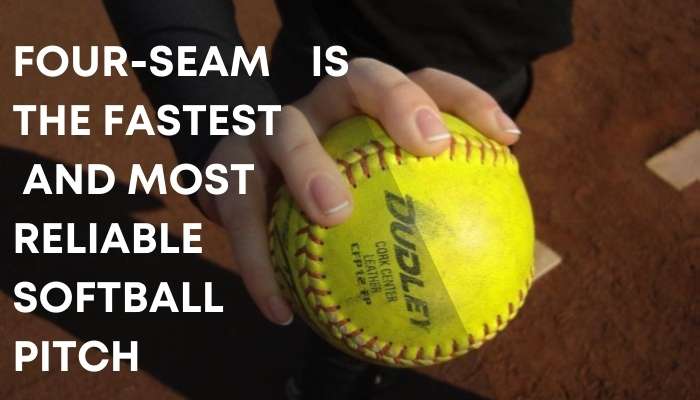
The opening should be facing you, so choose one and rest your fingers on the top, sideways. Position your thumb behind your index and middle fingers by stretching it back.
Put your pinky finger in a tuck or rest it gently on the side, but don’t really hold the ball in your hand. For a firm grip, rest the pads of your fingers against the seam.
Curl your fingers so that just the tips of your fingers touch the ball. To create spin, the “curl” plays a crucial role.
Stance
A pitcher’s balance and direction of his throw are greatly enhanced by her footwork and stance on the mound. Put your feet approximately shoulder-width apart and gently stagger them with your front foot on the side of your throwing arm.
If you’re just starting, the easiest way to throw a strike is to put your front heel on the rubber right in the middle of the mat. Your toes on the glove side should touch the pitching rubber but not go past it.
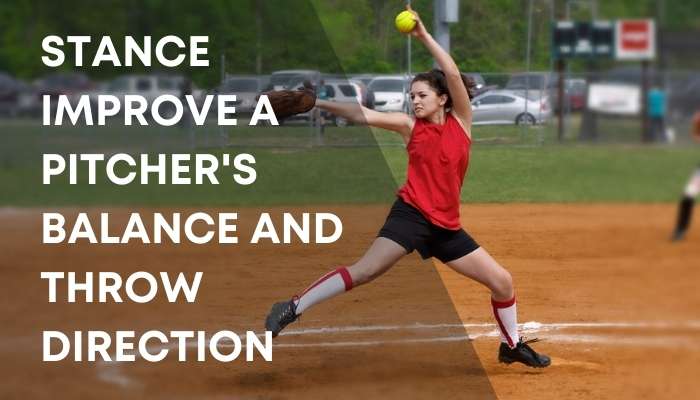
X Position and Arm Position
There are many different names for the X position.
- Power position,
- The K position and
- Position 12 o’clock.
Call it the striking posture, the punching stance, or the punching triangle, but once you’re in this position in your motion, striking is a breeze.
Land with your toes at 90 to 45 degrees on the power line.
In a proper throwing stance, the thrower’s arm is extended but not locked, the palm of the throwing hand faces away from the body, and the arm circle rests on the toes. Your arm will be visibly bent at the elbow, and your torso and head will be erect with your gaze fixed on the target.
The photo below depicts a pitcher in X posture with her arms looping in front of her body and toes.
Among 10 million softball players in the USA, roughly 90 percent of them are girls. But why is the number so one-sided? Why Do Girls Play Softball And Boys Play Baseball? All your questions are answered here.
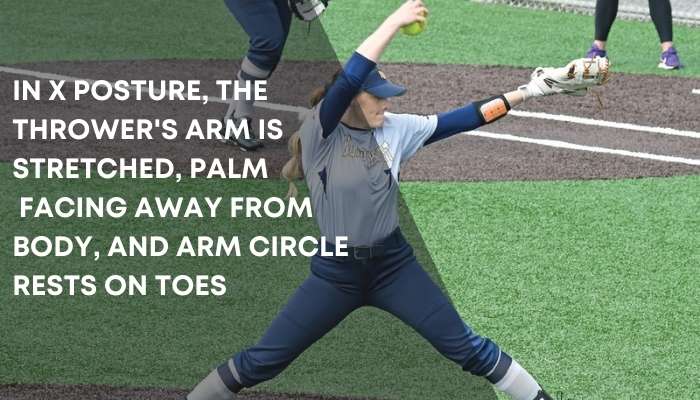
Arm Movements
A softball swing is composed of several discrete acts. Recognizing each element of the swing can help your team improve their pitches.
Check out these movements that make up a swing:
- Backswing
- Arm rotation
- Final downswing
- Release
- Follow-through
Back Swing– In my opinion, you should not put too much emphasis on the backswing. The backswing only sets the stage for the rest of the swing.
Players should try out different backswings in training until they find one that is good for them. Many people think a backswing is parallel to the ground. Others have different opinions.
Arm rotation in softball– For swing, arm rotation is very important because it affects how hard your pitch is thrown. Your arm and body will go forward automatically after the backswing.
Make sure the players rotate their arms at the same speed from start to end. Just maintain the power and the strength, and the pitchers can guarantee that their pitches travel at top speed.
One more important thing to keep the arm around. Keep the arm straight in line but do not ‘lock it’ out. This is a cause of serious arm injury.
Final Down Swing– Because the ball’s trajectory is so sensitive to so many different factors, the release is perhaps the most challenging part of the swing. Pitchers should maintain their wrists back as their arms come into their last downswing to maximize the ball’s snap.
Release– Keep your hand in that raised position as you let go. Before releasing the ball, the pitcher should look towards her palm, not the back of her hand.
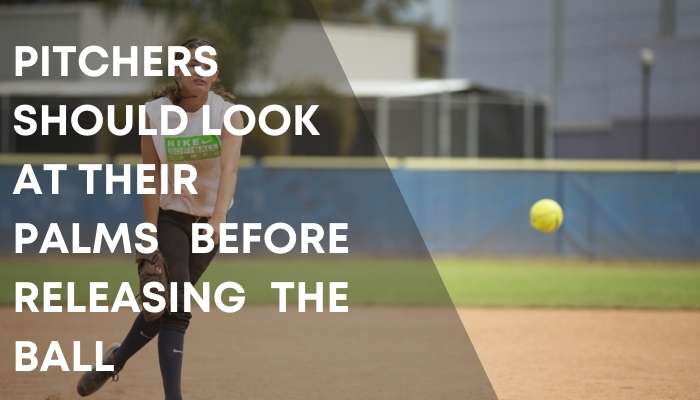
The body’s orientation is often overlooked, but this is a very important aspect. Pitchers should maintain their posture and avoid folding at the waist or bending to one side.
Keep the pitching arm outstretched to maintain a good posture, as it maximizes your pitching speed and power.
Pitchers should maintain complete body and head stability throughout the pitch, particularly during the release. It reduces their risk of injury and increases the accuracy of their throws.
The arm should be waist-high or slightly higher while pitching. This is the best strike zone, and good, fair pitches will be made most of the time.
Follow-Through– Pitchers must have a good follow-through after they throw the ball. The consistency of the follow-through is more crucial than its expertise and style.
Pitchers should always let their arms keep moving, so they don’t get hurt. Many players’ follow-throughs almost reach their shoulders, and their arms bend at the elbow.
Many pitchers find this stance natural and comfortable, but it’s not the optimum follow-through.
Is the baseball swing the same as the softball swing? Here I explained Softball swing vs baseball swing.
Footwork
Seeing those arms move about is interesting, no? Body and leg motions are the actual work and intricacy of throwing the pitch. As they throw, pitchers go through three distinct phases: closed, open, and closed.
When you see a pitcher pitch, notice that they directly face the catcher.
When the pitcher takes a step forward and starts the arm rotation, her body opens up, and she is no more facing the catcher, but rather, her side is towards the catcher.
At the end of the pitch, the ball goes through the final downswing. Notice that the pitcher’s body closes up, and the pitched ball goes directly to the catcher.
In my coaching career, I have seen many pitchers find this pattern difficult. You must be fully focused on the game and fully control your muscle.
Coaches should assist players in creating a routine and rhythm that allows synchronized arm and leg motions for a good pitch.
Check out these steps for a pitch that makes up perfect footwork:
– Stepping Stride
– Leaping Stride
– Drag
Pitchers’ stride is the step they take with their glove foot. When bringing the ball up and back during the arm rotation, players often take a huge stride forward with the leg that is opposite the glove hand. The stride represents this movement.
Even if a pitcher has a good arm and leg movement over a shorter stride, a longer stride often results in a better pitch. As the body’s weight is placed behind the ball during the stride, instead of the arm, the ball gains momentum.
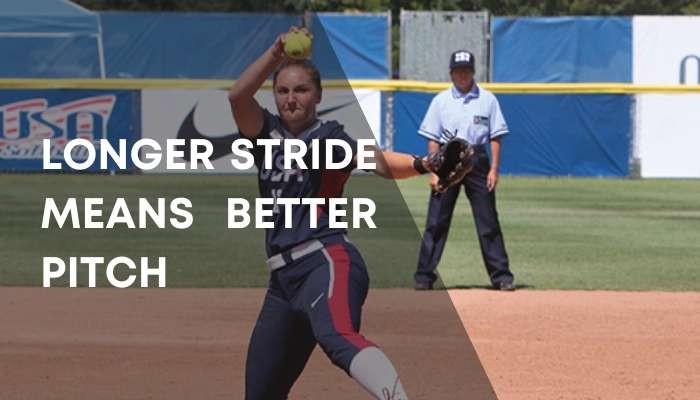
It also moves the pitcher forward to the plate, leaving the ball faster and tougher to hit.
By this explanation, you have already got an idea that striding has great importance in pitching. A good stride takes a lot of practice. I am sharing the same method here that I use with my players.
Get your pitcher into the box and ready to throw. Your girls should stride between 6 feet and 6 feet 6 inches. However, it might be challenging to convey this to players since it can be difficult to gauge how long your stride should be.
So, I like to place a cone at length I want my pitcher to stride. This gives them something to aim for and gives me a chance to see if they did it right after the pitch. So they can create a long, strong, consistent stride, and their muscle memory will control stride distance in a game.
Encourage your players to take strides equal to their height. If they can manage longer strides, that’s fantastic, but at the very least, they should try to stride the length of their body.
Encourage pitchers to expand their stride as they get more confident with the swing and its components. This helps pitchers maximize their power and stride correctly for their height.
Stepping Stride
Two methods for stride you will ever need. They are stepping and leaping. The stepping stride is ideal for new pitchers and those who want to concentrate on accuracy and the basics.
Stepping stride is quite simple. You just have to step forward and rotate your arm. Therefore, your stride will be shorter.
The stepping stride’s arm motion comes first, then the step. Stepping starts when the arm completes its downswing.
Remember, the stepping stride makes the pitching rubber push to the ground. It gives the ball the right amount of pushback and power to throw it.
Leaping Stride
Since the jumping stride/ leaping stride requires both feet to be off the ground at once, it is often forbidden under league and organization regulations. Pitchers frequently use drag to avoid real jumps. A jumping stride gives pitchers a longer, more aggressive stride.
Leaping stride makes your pitch fast and powerful. This stride type is more advanced than the stepping stride. This one is more difficult since it takes more thinking, muscular control, and strength.
Players should exert some forward force when landing on the leaping foot to generate resistance for the subsequent release. While the stepping stride absorbs the impact of the jump and presses against the ground for resistance, this one generates it by pushing off the rubber.
Drag
Leaping strides have a significant drag since it allows them in most common rulebooks. To maintain one foot on the ground at all times and make the jumping stride legal, the pitcher drags her back foot, or the pitching foot, on the ground while the opposite foot, the glove foot, leaps forward to assist the pitcher in creating speed and stretch for a successful pitch.
The drag is tricky in softball, requiring skill and accuracy to keep the foot firmly on the ground. Without enough forward velocity, the dragging foot will fall into the ground, slowing down the pitcher.
Do not put too much speed, as it might cause your dragging foot to leave the ground, which is a major strike against the pitcher.
You should point your foot like a ballerina while turning it to the side to drag appropriately. From my experience, I advise you to drag the inside of your feet towards the “big toe” side in order to get the most comfort and leg extension during their leaps.
As a general rule, a drag should last no longer than the distance a jumping foot travels before touching down again. More drag can reduce your balance and speed.
Power Line and Stride Length
Power Line has become the go-to place for softball skill development. The power line is centered on the pitcher’s mound and extends to the edge of home plate.
Your stride leg should fall on the power line with the toe angled 45 to 90 degrees from it. Beginners should aim for 90 degrees and hope the toe falls between 90 and 45, as 45 degrees is tough.
Your focus here is on pitch direction and maintaining balance on the mound. Generally, you throw from where you step. Therefore you should constantly go in that direction.
Your body balance gives your body control and power. When a pitcher’s body loses its balance, her mind takes control and uses her arms to counterbalance the lean. Loss of arms control makes it difficult, if not impossible, for the pitcher to throw strikes, if not impossible.
As I told you earlier, your stride should be as long as your body height. You should aim to land anywhere between your fifth and sixth steps when walking, stepping heel-to-toe. If your stride isn’t long enough, try kicking extremely hard with your stride leg.
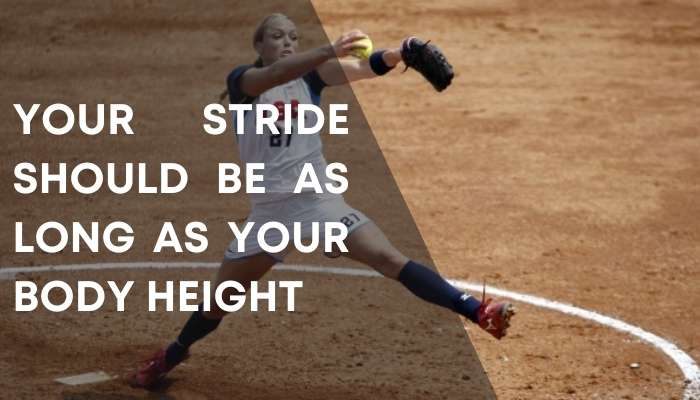
Spin
As you have come to the last part of the pitch, release, all you need to do is to finger roll. It will create ball rotation. The best way to learn how to spin is to throw the ball and spin it with your fingers. If you do it right, this very light and easy motion will give all pitches a drop motion.
Finish
There are two choices for finishing: remain sideways or pivot to face the catcher. I have taught both and succeeded with both, but I usually teach a sideways finish.
I have taught and succeeded with both, but I usually teach a sideways finish. This method is more challenging to master but results in more accurate throws.
To finish facing the target, the stride leg must turn, and the arms must make a helicopter motion. While this technique may be simpler to pick up than the sideways finish, it is harder to maintain control over your attacks. Whatever method you finish, you must accomplish two things: finish consistently and finish the throwing action before the catcher collects the ball.
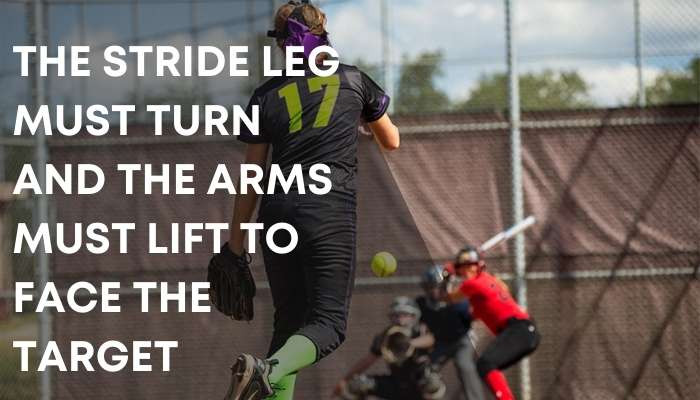
Practice
Remember the saying, “As mechanics improve, so will everything else?”? Pitching for beginners does not get better by just throwing thousands of pitches.
Every pitcher has to train with a goal in mind and be open to making changes as they go through their careers. Go hard on your practice. If you practice with terrible mechanics, you can expect the same in games.
Beginner softball pitchers should practice regularly but focus on perfecting their mechanics.
Beginner softball pitchers must perfect their technique by executing air through in the mirror. To be the greatest, you need ambition and commitment! Accept nothing less than the best.
Spins
One of the practices I tell my players to do is to raise the ball upward, about 3 feet, focusing on increasing spin. Do this 400 times per week.
X Position/ Power line/ Stride
Practice stepping onto the power line, landing there, and stopping at the X position. The best way to do this is on an 8 x 6 inches board. Do this 300–500 each week.
Arm Circle
Put your feet in an X position on the power line. Practice the arm circular while keeping the ball between your toes. Remember to spin the ball to the target.
Only step or lean forward once you see a noticeable improvement in your arm control. This drill is important for learning how to throw strikes because it lets you do a lot of them with little effort.
Full motion
Learning best by doing. Practice the full motion as often as you can, but don’t force it if you’re not ready. This could result in later wrong mechanics and injury.
Start each training with 10 balls so you can get better but don’t get bad mechanics. Let the pitcher toss, but if the pitch is too fast, let it go; just go on to the next ball.
Throw till all of the balls are used, and then call it a day. Count the total number of pitches and work to improve every day. It can be counterproductive to practice too much with bad form. If you want to improve your pitch count, do this three times a week.
Pitching Action in Five Easy Steps
A good pitching motion is based on a complex relationship between how the speed of body parts increases from the ground up. Make your pitching motion more professional by following these five steps.
1. With both feet on the rubber, a ball in each hand, a glove on, and a firm grip
2. Separate your hands, and place your weight on the back foot, but do not take a step back.
3. Both arms travel forward, step, and turn the body. The glove hand stops when the arms are parallel to the ground, and the ball hand continues in a circle beyond the head with the ball pointing back. You just did the “Power Position”.
4. Keep the ball in your hand, lower your glove hand and smack it on your thigh, then flip your wrist to the 6 o’clock position to let go of the ball.
5. Rotate the hips till the chest is towards the goal.
Tips for Softball Pitcher Beginner
Are you interested in a different role in softball? Don’t worry I have got you covered. Here are the best softball tips for beginners you will ever need.
Softball pitching at first may seem difficult. With proper tips and guidance, you can also master it. Here I will share some of the tips I give my players.
Proper Pitching Stance
The pitcher’s pivot foot must touch the plate in Little League Softball. To be good in pitching stance, practice aligning the pivot foot’s arch with the plate’s leading edge so that the foot may push off.
The stride foot should be on, or just behind, the rubber, and the feet should be staggered and spaced at shoulder width. Your legs must be sturdy enough to support the body.
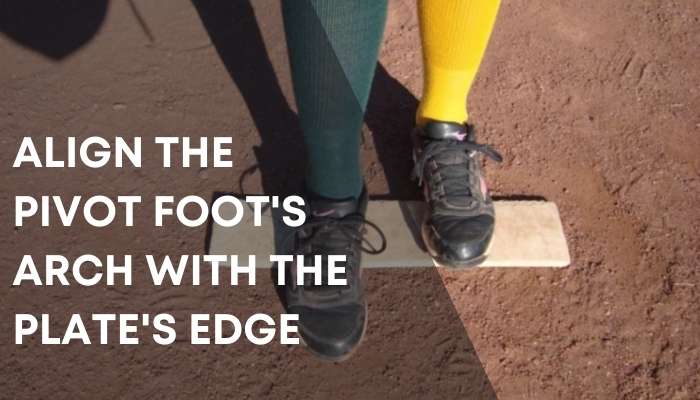
Start and Rotation
Most often, Little Leaguers swing their throwing hand beyond their hip and into a backswing. Once the hand starts moving forward, pitchers should move their weight from their back leg to their push-off leg.
Your pitchers should rotate off the pitcher’s plate with their pivot foot, similar to sprinters leaving the starting blocks. As pitchers move toward the plate, their bodies turn sideways (right-handed pitchers’ belly buttons face the 3rd base dugout) into a K or X shape.
Finish and Follow-Through
Pitchers throw from the K or X stance, whipping their arm and the ball down toward the catcher’s glove. The arm should remain relaxed and continue to the target.
Many players may try to “lock down” a pitch or “muscle” it. You should just tell them to chill down. Little Leaguers should stand tall and keep their bodies still the whole time they pitch.
Take note of how your pitcher is holding her head and body. Is the pitch centered and hitting the glove?
If not, tell her to maintain her head as level as possible and her shoulders as level as possible. Last but not least, the stride foot needs to hit the ground hard.
If it falls softly, the acceleration will be reduced. Also, watch the length of your stride length. Balance and power are the keys, so if your pitcher is having trouble, make sure that their stride isn’t too long and stretched out.
Change Targets
One thing I have often seen is when a young player is having trouble in the circle and is frequently off-target, some coaches make the mistake of giving their pitcher a lot of corrections. What I do is tell my pitcher to adjust her aim if she often strikes out on the inside, outside, high, or low.
If the pitcher throws outside and high, tell her to aim for the catcher’s left knee instead of her glove.
Relax and Rhythm
Advise your athlete to ease up from the shoulders to the jaw. Pitching can be stressful. Let your pitchers find a rhythm that feels good and fits the pace of the game.
Make sure that your pitcher is not throwing too fast. Each pitch has to be systematic and precise.
Make the Batter Invisible
Every coach knows that a pitcher can be awesome when there’s no one in the batter’s box, but once a player steps up, the pitcher’s control is often less good. Even though it’s easier to say than to do, tell your pitcher to focus on the target and act like the batter isn’t there.
Try to tell your Little Leaguer that she and her teammate are just playing catch behind the plate.
When giving pitching tips to beginner softball players, it’s best not to go into too much depth. The information can be overwhelming to them.
They are not professional. Keeping it basic will produce good outcomes, keeping the game fun.

One way to easily boost the morale of your students is giving them gifts for their little achievements, This may seem a very little effort, but it can do much more than you will ever realize. Here are the best Softball Gifts for Team you can consider.
As important, don’t forget that you’re the coach. It’s on you to be the teacher and ensure your Little Leaguer does what he’s told.
If a pitcher is receiving too much advice from others, ensure it’s in line with what you’re teaching.
Statista observed that there are almost 10 million softball players in the United States, of which eighty-five percent are women. So, as a girl, your career opportunity in softball is enormous. My article on How To Become A Better Slow Pitch Softball Hitter will interest you heavily for the batter role in softball.
Observations To Make:
As a beginning softball pitcher, you should keep an eye on these factors.
- Does the ball start at the target while pitching?
- Keep your chin up or as high as you reach, and don’t lean at any point.
- Getting rid of outside the strike zone pitches
- Too high of a pitch, too late of a release.
- Too low of a pitch, too quick of a release.
- Not starting the arm circle in the right direction
- Maintain positive body language.
Frequently Asked Questions
1. What Is the Easiest Pitch in Softball?
Beginners softball pitchers would do well to study the screwball, a kind of breaking pitch that is both simple and effective. It’s essential to start with the basics while developing your pitches. The screwball is one kind of such pitch. Most pitchers throw a screwball sidearm.
2. What Pitch Should I Learn First?
The four-seam fastball is the first pitch that you need to learn. This is often the simplest pitch to strike a batter with. If the ball is thrown correctly, its four laces will spin as it goes through the air. This helps the throw stay on target.
3. Why Is Softball Pitching So Hard?
The ball is thrown when a major league pitcher’s arm spins inward at around 7500 degrees per second. This rotation speed makes shoulder and elbow stress challenging to tolerate.
4. What Are 3 Things You Need to Do in Order to Pitch a Softball Properly?
As a softball pitcher, you must focus on three things above all others: your balance, hip close, and wrist snap. To be a good pitcher, you need all three of these things.
5. What Makes a Good Pitcher in Softball?
Pitchers really MUST understand the importance of being highly adaptable in their profession. They need to be able to confidently and swiftly try something new if what they’ve been doing so far isn’t producing the desired results.
Wrapping Up
Pitching for Beginners in Softball is just as crucial as other practices in softball. Making a pitcher takes a lot of skills, some of which people are born with it and many of which they learn through training and hard work.
According to Seaver, “it’s an art to learn how to do it.” As the saying goes, “They have to want to do it in order to do it well.”
One thing to remember, you are in charge. Your Little Leaguer is under your care, and your job is to educate them. Avoid giving them too much guidance. They won’t be able to apply anything because they’ll grow overwhelmed.
Don’t rush! I have faith in you. Make a practice plan and accomplish things in an orderly manner. I hope that everything you are working so hard on pays out for you in the end.
You May Also Be Interested In
How Are Softball Pants Supposed To Fit: Coach’s Guide
7 Best Softball Sunglasses In 2022 [Become Stylish and Efficient]
Easton MAKO TORQ Helmer Review | The Best Sweet Spot Softball Bat
Miken Softball Glove Reviews | Let The Ball Rest Comfortably In The Model

Hello everyone. My name is Jason Butler, and I live in California, America. I was a professional AAA Minor League Baseball player. I lost my chance of playing MLB for injury issues, but I did not lose my love for baseball. I attended the coaching training program and am now working as a coach in a small school in San Diego.
I always love to share my experience and knowledge if that can help you. Play baseball, and stay fit.
